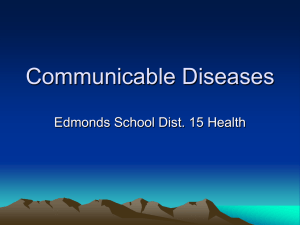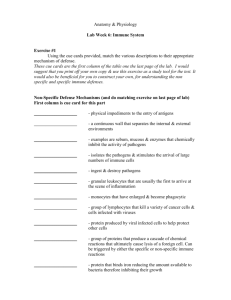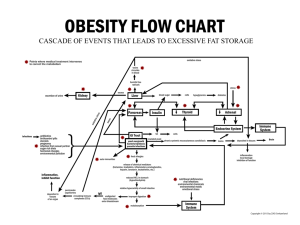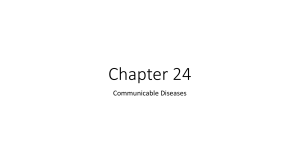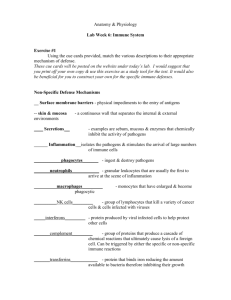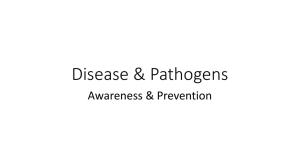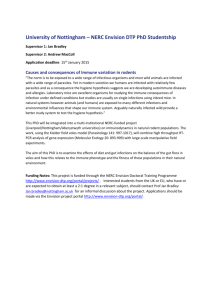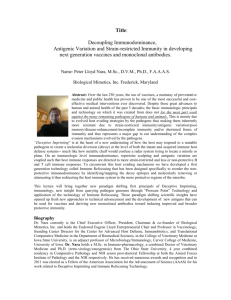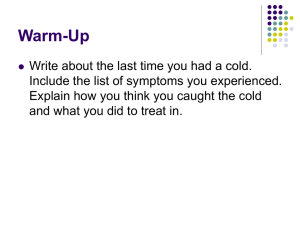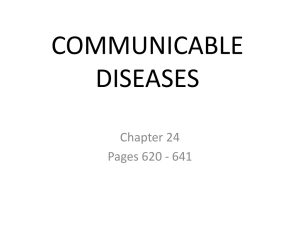24.1 PPT
advertisement
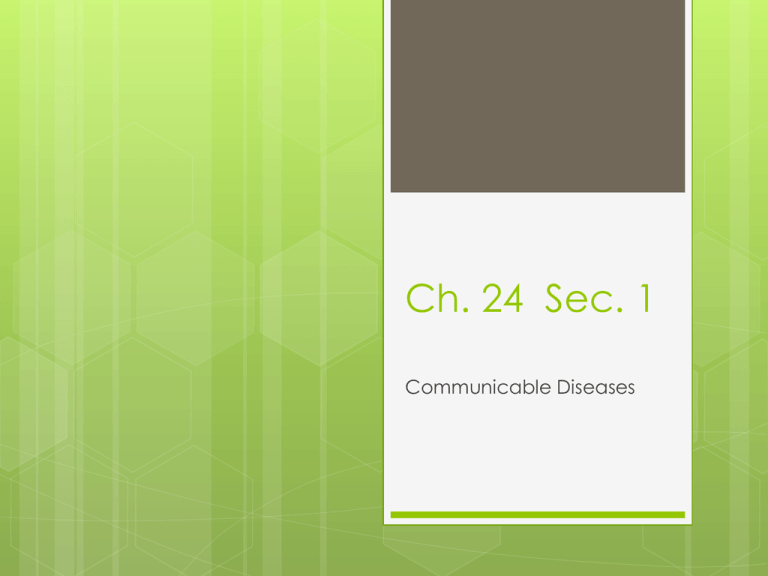
Ch. 24 Sec. 1 Communicable Diseases What are Communicable Diseases? Any disease that is spread from one _______________ thing to another Any disease that is spread through the _____________________ Causes of Communicable Diseases Pathogens are _______________ that cause disease. The following are pathogens: _________________ Bacteria _________________ Protozoan Rickettsia Virus Viruses need living cells to _______________ Viruses invade all known forms of life Viruses need to run their course and then be killed by your _______________ system Antibiotics do _______ work against viruses What does a virus do? Attaches itself to a cell (_____________) Controls the host and tells it to make more New infected cells break off from the host The host dies New infected cells take over other ____________________ cells Process repeats Bacteria ___________-celled First living organism on the _____________ Most are harmless Many are essential for healthy lives Can ______________ and multiply Most can be treated with antibiotics Fungus _____________________ organisms Mold Yeast Can infect the lungs (mucous) Can cause diseases of the skin ______________________ ______________________ Protozoan and Rickettsias Protozoans are _______________-celled Larger and more complex than bacteria Most are _________________________ Rickettsias resemble bacteria Enter the body through _______________ (insect, flea) How are diseases transmitted? Direct Contact ____________________ Contact Vectors Water/Food ____________________ Direct Contact You must ‘touch’ an infected person or _______________________ Touching, Pregnant biting, kissing, sexual contact mother to unborn _____________ Indirect Contact Coming across contaminated objects Touch the object then touch your ______________, ____________, and/or __________ Can be prevented by __________ ________ Vectors Any organism that can carry pathogens Ticks Mosquito _________ Water/Food Careless handling of water/food supplies can lead to infections Water supplies can be contaminated by human or animal ________________ Hepatitis A Airborne Pathogens can live and travel through the ___________ From a __________ or ____________ Chicken pox, tuberculosis, flu Prevention Wash hands often After using _____________________ Before preparing food Before putting contacts in When someone around you is ill Other Preventative Measures Do not handle body fluids or waste products Clean surfaces after food has touched them Cook ____________ to proper temperature Avoid sharing utensils, cups, Get ________________________ (shots!) Avoid those who are ___________ Ch. 24 Sec. 2 Communicable Diseases and your Body Our Bodies Your body is exposed to millions of _________________ everyday, all day Your immune system fights them off _____________ acts as first defense Immune system goes to work next Immune System The immune system has two major defense strategies: Inflammatory Response __________________ Response Vaccines ______________ or weakened pathogens are injected into the immune system Causes the body to produce a _________________ without causing the actual disease Types of Vaccines ____________-Virus Made from live pathogens grown in a lab ____________-Virus Made from dead pathogens Toxoids Made from inactivated _______________ New and Second Generation Vaccines Made from genetically altered yeast cells Care of Immune System Keep ___________________ Eat proper diet Get plenty of ______________ and ___________ Avoid sharing personal items Keep immune system strong Ch. 24 Sec. 3 Common Communicable Diseases Most Common Communicable Diseases Respiratory Infections __________ __________ Pneumonia __________ __________ Tuberculosis Hepatitis (A, B, C) Respiratory Infections Most common Can occur anywhere Avoid close ____________ with those who are ill Keep hands away from mouth, eyes, nose _________________ can contribute Cold ______________ No infection cure Runny nose, sneezing, sore throat Mucous membranes become irritated Most common way is to pick up the virus by touch and then rub your eyes, nose, or mouth Flu (Influenza) _______________ No infection cure Vaccine available to prevent High fever, fatigue, headache, muscle ache Plenty of rest and fluids Strep Throat ________________ infection Usually spread by cough/sneeze Sore throat, fever, enlarged lymph nodes in neck area A throat culture is taken to identify Tuberculosis _________________ Infection Spreads through the __________ Attacks the ____________ Most people will be infected with this, but their immune system will fight it off (the person will never get sick from it) Fatigue, coughing blood, fever, weight loss Hepatitis _______________Infection Inflammation of the liver Spread though blood, infected needles or sexual contact Hepatitis C Spread through feces Hepatitis B cure Vaccines for type A and B Hepatitis A No Most common Spread through blood Leads to liver cancer or failure Ch. 24 Sec. 4 Emerging Infections Future Infections Communicable diseases have increased in humans and animals in the last 2 decades This could affect future generations of humans and animals Transported across Borders Humans and animals are affected by disease brought in from other countries West Nile Dengue Fever Both carried by __________________ Population Movement Movement of people In heavily _________________ areas (ticks) Areas of certain species (spiders, insects) Resistance to Antibiotics Some diseases have developed certain __________________ that are no longer affected by medicines (they are immune) Tuberculosis Gonorrhea Pneumonia Changes in Food Technology Mass production of food (in plants and packing companies) increase the chances for _____________________ E.Coli Salmonella Botchulism Agents of Terror Governments or anti-government groups have begun using diseases as ____________ Bioterrorism Smallpox Outbreaks
